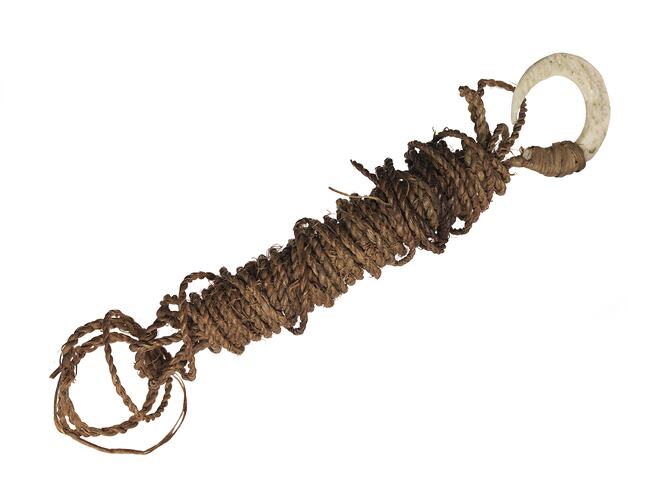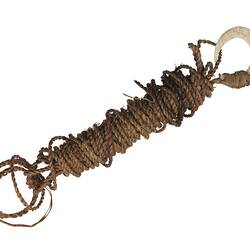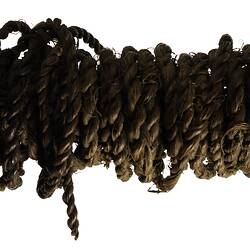Summary
Acquired by Melbourne Museum sometime around 1888, this extremely rare koy-yun was made by the Gunai/Kurnai peoples from the Bunyarnda (Lake Tyers) Mission in Gippsland. The land of the Gunai/Kurnai people, Lake Tyers Mission became home to Aboriginal people from all over Victoria when they were forcibly removed from their homelands. Bunyarnda, the true name of Lake Tyers mission, situated in a captivating landscape and surrounded by coastal bush land and beautiful waterways that provided abundant fishing grounds. The Gunai/Kurnai traditional lands extend along the eastern coast of Victoria and inland to the southern slopes of the Victorian Alps.
A popular technique for thousands of generations, line fishing was traditionally practised by women in south-eastern Australia, who were renowned as expert anglers. The women would first make nets with a closely woven mesh to procure bait for fishing on the hooks and lines. The nets were stretched on a bow and let down to the bed of the stream, then drawn up through the water, capturing the bait.
Local Name
Koy-yun/Yowan
Physical Description
Koy-yun (fish hook) made of bone (possibly kangaroo) and bark. The bone hook is a crescentic section almost forming a full circle. It is flat and both the inner and the outer edges of the curve have been bevelled. Twisted bark fibre string is attached to the neck of the hook by a tightly bound bark strip. The strip is not twisted and binds 16mm of the string to the bone. The bone is formed into a crescent shape, and the fishhook is attached to a yowan (fibre string), made from the inner bark of the Blackwood tree which has the unique advantage of being both strong and flexible.
Significance
Gunai/Kurnai Elder Uncle Phillip Pepper shares his cultural knowledge of the processes used by Gunai/Kurnai in constructing fishing equipment;
'They did a lot of spear fishing, at Bung Yarnda, (or Lake Tyers) with the kangaroo bone. They had these big rocks for sharpening bone and axes on and they'd sharpen up points on the bone, then get the sinew from a kangaroo tail and fasten the bone with it to a lump of tree neatened into a stick. Next the resin from a tree was heated and poured over the binding and they were ready for fishing.' Uncle Philip Pepper, 2010
The availability of European hooks and lines meant that traditional wood and bone fishhooks became rare in the south-east in the late 19th century. This fish hook is the only example of traditional bone fishing hooks and lines known to exist.
The Gunai/Kurnai have a strong historical and ongoing connection to the Gippsland region with many of their significant sites are associated with water resources. It is a testament to the Gunai/Kurnai people's relationship, knowledge of and respect for their Country that the Gippsland Basin bioregion is home to some of Australia's most pristine waterways. On 22 October 2010 the Federal Court recognised that the Gunaikurnai hold native title over much of Gippsland. On the same day, the State of Victoria entered into an agreement with the Gunai/Kurnai (Recognition and Settlement Agreement) under the Traditional Owner Settlement Act 2010.
References
Keeler, C. and Couzens, V., (eds) 2010, Meerreeng-An, Here is my Country: The Story of Aboriginal Victoria Told Through Art, p. 127, Koorie Heritage Trust/BPA Print Group.
More Information
-
Object/Medium
Hook
-
Maker
-
Locality
-
Date Produced
-
Collector
-
Date Collected
-
Object Measurements
140 mm (Length), 45 mm (Width), 40 mm (Height)
-
Classification
-
Date Made
-
Maker
-
Clan/Language Group
-
Place Made
-
Indigenous Region
-
Keywords
-
References
[Book] 1992. Women's work: Aboriginal women's artefacts in the Museum of Victoria.
-
Type of item
-
Discipline
-
Category
-
Collecting Areas





